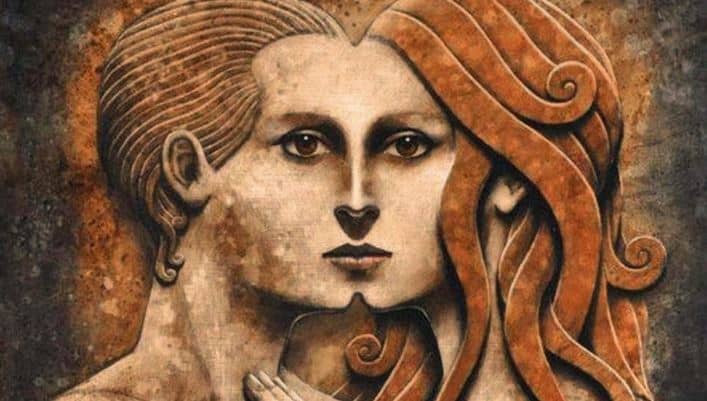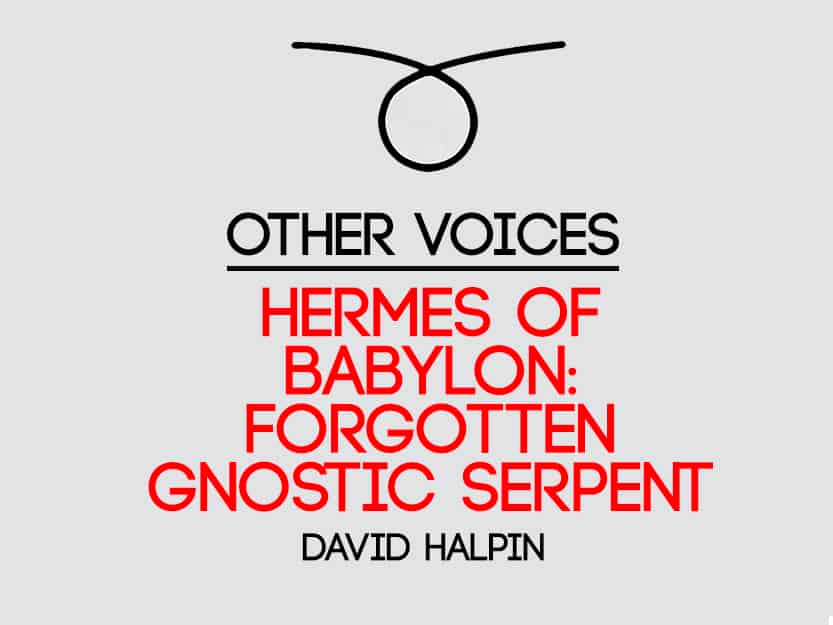So, good people of the internet here we are again with another edition of OTHER VOICES! This time we take a look at Hermes with the great David Halpin…

Darren Aronofsky’s 2014 film Noah was variously described as being “…likely drawn from Gnostic texts that present the biblical god as evil.” and as “…merrily lifting riffs from a range of canonical and Gnostic texts, with a sprinkling of the Kabbalism about which he obsessed in Pi.”(1.) (2.)
The film depicts the archetypal world flood myth concerning Noah and his instructions to save two of each living thing on an ark.
However, descriptions referring to the Gnostic elements of the story allow us to dig a little deeper into the roots of this constantly evolving philosophy.
Unfortunately omitted by Aronofsky, the story of Noah, as most scholars agree, is based upon the various Babylonian flood myths of Ziusudra, Atrahasis and Gilgamesh which are much older than the Bible. As a comparison, the book of Genesis was compiled around 500BC from earlier lost sources potentially going back another 400 years, whereas the flood myth in The Epic of Gilgamesh dates to 1500-2000BC and fragments of deluge stories exist on tablets dating even earlier. (3.)
If, as is shown with the Noah myth, the Old Testament originates from older Babylonian and near eastern myths then we are also obliged to re-examine our ideas about Gnostic origins as the Old Testament is from where these thinkers drew some of their most important ideas.
There are many scholars who advocate a closer study of parallels between Hermetic Egyptian groups and Gnosticism, most notably, John Turner, an expert on Sethian Gnosticism.
Jean-Pierre Mahe, writing in The Nag Hammadi Scriptures notes similarities between Gnostic texts and the Corpus Hermeticum specifically in relation to Genesis commentary. (4.)
So, is there a relationship between Hermeticsim, Gnosticism and Babylon?

In fact, we find a very strong relationship once we dig a little deeper than most Gnostic scholars have tended to do so far.
The earliest accounts of the caduceus of Hermes, for example, come from the Sumerian god Ningishzida, dating back to 4000BC (5.) (6.)
Writing in The American Journal of Archaeology, A. L. Frothingham notes that Hermes was an Oriental deity of Babylonian extraction and a snake-god. (7.)
Apart from some similar cornerstones, the Gnostic creation cosmogony has many saviours and villains and sometimes their roles reverse from group to group, most notably the snake or serpent. The Ophites, a Sethian Gnostic sect, believed the serpent to be a redeemer as it helped Adam and Eve achieve true knowledge and broke the spell of the Demiurge, or false god Jehovah.
In the creation myths of the Gnostics we go further back than Adam and Eve to a time when the true, transcendent God began to emanate all things, visible and invisible. These were aspects or traits of himself known as aeons and were emanated in male and female pairs.
These aeons can be seen as mythic god-like characters or in a deeper psychological sense where they are aspects of the mind. They are the intermediaries between us and God but have been corrupted in the sense that they are now so far from God that they have forgotten their source, the Pleroma, or ‘The Fullness’.
The most important emanation in terms of this separation is Sophia, the aeon representing wisdom. Sophia, through error and in trying to reunite with God also emanated a being, Ildaboath, the Demiurge.
In Platonic thought the Demiurge is the creator of the material universe and not necessarily bad, but in Gnosticism this is the God of the old testament and the prison keeper between human beings and our reunion with the original God from which all things had come.

From here the stories can change quite dramatically but tend to include a redeemer figure descending to the earthly realms in order to rescue Sophia and the divine spark which exists in all things and can be released through gnosis. This redeemer takes many forms including a purely spiritual Jesus, Simon Magus and the serpent.
This redeemer as Jesus in the Gnostic texts is much more eastern in outlook and shares many traits of Hermes as that of messenger. Elaine Pagels writes that, “Instead of coming to save us from sin, he comes as a guide who opens access to spiritual understanding.” (8.)
Hermes is known as a bringer of light and knowledge and he is also represented by the symbol of the serpent. His Babylonian and near eastern roots are well documented by scholars so re-establishing his place within the Gnostic cosmogony seems quite valid and, indeed, just.
The Gnostic poet and artist, William Blake, perhaps best describes this message of individual enlightenment, as opposed to blindly following a dogmatic faith system, when he writes, “The vision of Christ that thou dost see is my visions greatest enemy.” (9.)
If figures such as Hermes, Noah and Adam and Eve have their roots in older Babylonian myths then perhaps Gnosticism itself should be reconsidered accordingly.
***
(1.) http://www.theguardian.com/film/2014/apr/06/noah-review-preposterous-epic-russell-crowe
(2.)http://www.wsj.com/articles/SB10001424052702303532704579477221314766160
(3.) Andrew George, page 101, “Early Second Millennium BCE” in Old Babylonian.
(4.) The Nag Hammadi Scriptures. Edited by Marvin Meyer. (P798.)
(5.) Turner, Frederick. Natural Religion. Transaction Publishers. ISBN 0-7658-0332-1.
(6.) Gary Lachman, “The Quest for Hermes Trismigestus”, 2011, Chapter 3, p.x
(7.) Babylonian Origin of Hermes the Snake-God, and of the Caduceus I
A. L. Frothingham
American Journal of Archaeology
Vol. 20, No. 2 (Apr. – Jun., 1916), pp. 175-211
(8.) Elaine Pagels, The Gnostic Gospels p19
(9.) William blake The Everlasting Gospel.

David Halpin is a writer from Carlow, Ireland. He is a regular contributor to various Fortean and occult magazines and websites. David also reviews occult and anomalous titles and his video reviews can be found on YouTube at: https://www.youtube.com/channel/UC3j9uYsQd8T-gfgYj3m556w
Twitter: https://twitter.com/OccultReview>
David’s folklore research can be found on Facebook HERE!

If you want to help me out and allow me to continue doing what I do or to level up,
then there are a number of ways you can do so. Obviously, there is no obligation
or pressure to do so, but if you do I thank you from the bottom of my heart!
Buy The Forty Servants DECK – DELUXE DECK – GRIMOIRE – or – ART PRINTS
Join the PATREON!
Send a donation via PAYPAL
Buy me something off my AMAZON WISH LIST
Share the videos, website, blog posts etc on social media
LINKS & STUFF:
BLOG
– ADVENTURES IN WOO WOO
THE FORTY SERVANTS
– All Info on The Forty Servants here!
THE FOUR DEVILS
– INFO AND DOWNLOADS
– SIGNED ALTAR CARDS/ ART PRINTS
MEDIA
– Adventures in Woo Woo Show
– Tommie Kelly Youtube
SOCIAL
– Adventures in Woo Woo Facebook
– The Forty Servants Facebook Group
– Twitter
– Discord
– Instagram
–
